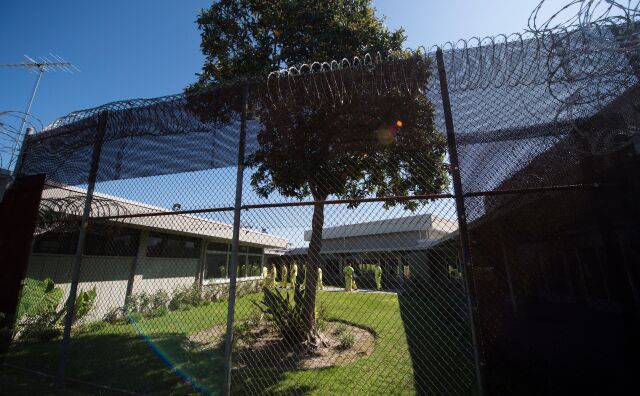Copper wire thieves have damaged the LA Metro system, darkened swaths of neighborhood streetlights, and swiped cell phone towers for years.
Now, L.A. City Councilmembers Traci Park and Kevin de León are calling for a new LAPD task force to fight back against the spike in copper crime that's costing the city millions of dollars each year.
“The city, quite literally, is being stripped for parts,” de León’s motion said.
About the issue
Park, whose 11th district includes West L.A, Venice, and Brentwood, told LAist copper wire theft is one of the most serious problems the city is facing.
-
It's gonna be Yankees v the Boys in Blue
-
What candidates can — and can't — say they do
-
Nonprofit's launching fundraiser to keep it afloat
There’s been nearly 400 thefts reported using the MyLA311 app since 2020 in her district alone, Park said, and that doesn’t include the number of reports to the LAPD or other agencies.
“Thieves and vandals have tampered with traffic signals in our intersections, with rail crossings, and other infrastructure that actually puts people's lives at risk,” she said. “So this is something that we just simply cannot tolerate.”
Miguel Sangalang is the director of the Bureau of Street Lighting, which handles all of the streetlights for the city of Los Angeles.
That includes roughly 250,000 streetlight assets, connected by about 9,000 miles of underground conduit and 27,000 miles of copper wire, which covers two-thirds of the city.
Sangalang told LAist it’s not unheard of to have these kinds of thefts because the components in an electrical system are valuable, but the pace of the problem has reached a level they’ve never seen before.
He said they’ve dealt with a tenfold increase in repair reports over the last five years — from about 500 to 700 incidents on average to nearly 7,000 a year.
South L.A. and downtown are some of the hardest hit areas. Sangalang said the San Fernando Valley also sees a similar number of incidents, but they’re more spread out and not necessarily concentrated in one neighborhood as in other parts of the city.
Cost of the crime
The thefts from last year alone cost the city an estimated $17 million in repairs, Park noted.
With L.A. heading for some difficult budget decisions in the next fiscal year, she said that’s a lot of money going towards fixing criminal activity rather than addressing homelessness, repairing sidewalks, or other essential services.
“It isn't a drop in the bucket, not at all,” Park said. “That is going to come at the expense of additional sanitation workers, or getting potholes filled, or addressing other dangerous conditions.”
Sangalang said copper wire thieves typically rip into the infrastructure, which can knock out several streetlights. He said getting them working again isn’t as simple as changing a bulb — it’s more like rewiring a whole house.
He said they have to send out multiple electrician crews to pull out all of the wire and reconnect it, which can take several hours. It costs about $36,000 to repair, and strengthen, one circuit and the 18 lights connected to it.
“We've been struggling because those are things that we've had to ask the mayor and city council to actually fund us,” Sangalang said.
He added that they’ll have to make some tough choices in the near future as the city faces the fiscal reality of a tight budget.
How they’re hoping to fix it
Park and de León introduced a pair of separate, but related motions late last month.
The first, from de León, calls for a Copper Wire Task Force that would tackle thefts in downtown L.A., Boyle Heights, El Sereno, and Lincoln Heights — all communities in his 14th District.
Thieves have damaged more than 3,700 streetlights in those last three areas alone by ripping out the copper wire, according to the motion.
The 6th Street Bridge has also been a popular stop. De León said criminals have stolen tens of thousands of dollars of copper wire from that infrastructure in recent weeks. He also offered $200,000 of his district funds to help cover the cost of the task force.
The second motion, from both Park and de León, would create a reward program designed to encourage people to report copper wire thefts and streetlight crimes in the city.
Park said their proposals would add onto the other work the city has done to combat the issue, including warning letters sent to recyclers about the potential criminal consequences of stolen copper.
“This is a problem that none of us should have to put up with,” she said. “What we're seeing is multiple tools being made available that can be utilized together to have a comprehensive crackdown on this citywide.”
Sangalang said they have to leave the investigative work to the LAPD, but the Bureau of Street Lighting has also been taking steps to deter thefts.
For example, they’ve started fortifying specific lights by using cement, steel, and concrete to hide all of the accessibility points.
“Think of it as building the biggest castles we can around our streetlights,” Sangalang said.
That process can take several days, if not weeks. He said there was one streetlight in South L.A. they were working to repair and fortify for nearly two months.
They’re also looking at deploying sensors and cameras to try and safeguard certain areas, especially those that have been hit by “repeat customers.”
“Looking at smart technology that can actually give us alerts, so that we can share some of this information with the enforcement side of the city and try and deal with that as well,” he added.
They’ve also added about 90 all-in-one lighting systems that are solar-powered and battery-enabled.
Sangalang said those are easier to repair, and it makes the lights more resilient.
“The power system might go out,” he said. “Well, we'd still have emergency lighting in the form of battery backup for several days.”







